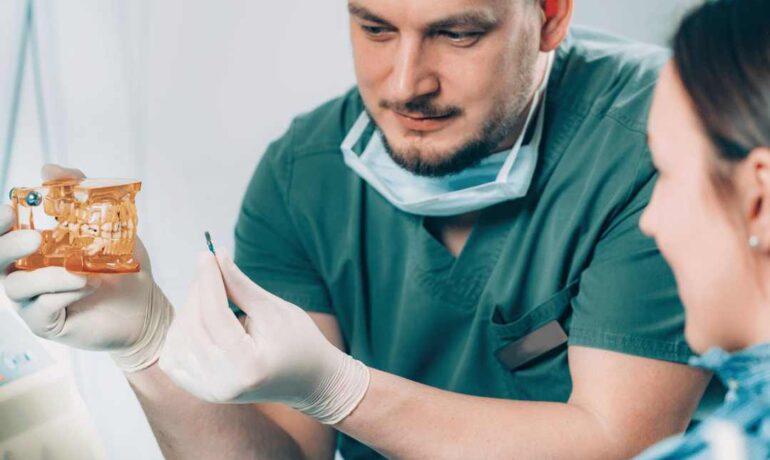When it comes to getting dental implants, bone grafting often becomes a crucial part of the process. If our dentist in Upland Dental Practice has mentioned that you might need a bone graft, don’t worry—this isn’t uncommon. Let’s break down why it’s necessary, how it works, and what you can expect.
Why Do I Need Bone Grafting?
You might be wondering, “Why is a bone graft even necessary?” After a tooth extraction, the jawbone in that area can begin to shrink or weaken over time. This happens because the bone no longer has the stimulation it used to get from your tooth roots. Without enough bone, a dental implant won’t have the support it needs to stay in place. A bone graft helps rebuild the structure, making sure your implant has a solid foundation. Think of it as preparing the soil before planting a tree—it ensures everything stays stable in the long run.

What Happens During a Bone Grafting Procedure?
The idea of a bone graft might sound intense, but the procedure itself is pretty straightforward. Here’s what our dentists do in Upland Dental Practice:
- Assessment: Our dentist will first evaluate how much bone you’ve lost and decide what type of graft is needed. This usually lasts between 30 minutes to an hour. The process can include reviewing your medical history and evaluating your jawbone, gums, and surrounding teeth. Imaging might be taken to further assess bone density. Only after these steps will treatment options be provided.
- The Graft: If you’re a candidate for bone grafting, the bone material—which can come from your own body, a donor, or even synthetic material—will be placed in the area needing support.
- Healing: Over time, the graft integrates with your natural bone, creating a strong base for the implant.
In some cases, the graft can be done at the same time as the implant placement. If not, you might need to wait a few months for the graft to heal completely before moving forward.

How Long Does a Dental Bone Graft Take?
The procedure itself usually doesn’t take long—sometimes just an hour or two, depending on the complexity. But healing is where patience and proper care is key. It typically takes 3 to 6 months for the graft to fully integrate with your natural bone. During this time, our dentist will monitor your progress to make sure everything is on track.
As for recovery, most people report mild discomfort, which can be managed with over-the-counter pain relievers and following our dentist’s aftercare instructions.
What Are the Risks of Bone Grafting for Dental Implants?
Like any medical procedure, bone grafting comes with a few risks, but serious complications are rare. Some potential risks include:
- Infection – according to a population-based study on the risk factors of bone grafting, only 3.05% of post-grafting infection has been reported after a 16-year research.
- Swelling or discomfort
- Rejection of the graft material (very uncommon)
Most of these issues can be minimized by following our dentist’s advice and maintaining good oral hygiene.
Is Bone Grafting Successful for Dental Implants?
The short answer is yes—bone grafting has a very high success rate, especially when performed by an experienced dentist.
In 2021, there was a comparative evaluation of different bone grafts for dental implants. A total of 41 studies were reviewed, focusing on factors like study design, number of implants, participant count, graft type, graft source, time between bone grafting and implant placement, and implant success and survival rates. After 1 to 5 years of follow-up, the success and survival rates were:
- Block grafts: 91.5% success, 75% survival
- Blood derivatives: 91.5% success, 96.7% survival
- Composite grafts: 80.9% success, 94.2% survival
- Xenografts and particulate grafts: 100% success and survival
These numbers indicate the likelihood of a bone graft successfully integrating and supporting a dental implant, with xenografts and particulate grafts showing the highest success and survival rates over time.
Success, however, still depends on factors like your overall health, how well you follow aftercare instructions, and avoiding habits like smoking, which can affect healing.
Common Questions About Bone Grafting for Dental Implants
How painful is a bone graft for a dental implant?
Most people report mild to moderate discomfort after the procedure, similar to what you might feel after a tooth extraction.
How long do bone grafts last?
Once the graft integrates with your natural bone, it’s essentially permanent. With proper care, the results can last a lifetime.
What materials are used for bone grafts?
Bone graft materials can come from different sources:
- Autografts: Your own bone (often taken from another area of your jaw or body).
- Allografts: Donor bone from a bone bank.
- Synthetic materials: Lab-made materials designed to mimic natural bone.
How much does bone grafting cost?
The cost can vary widely depending on the type of graft and your location. But in California, for instance, it typically ranges from $300 to $3,000. To get an accurate estimate and understand what your insurance covers, we recommend consulting our dentist. If you don’t have insurance, consider our membership program, which offers discounts on implants, required X-rays, and extractions.

Consult Us at Upland Dental Practice
Bone grafting it’s a tried-and-true method to ensure your dental implant has the best chance of success. While the process might require a bit of patience, the long-term benefits are worth it. If you have any concerns or questions, don’t hesitate to schedule a free consultation with our dentist in Upland Dental Practice!


